Hello all i know it isn't a plc question but with time i have seen a lot of knowledge here on motors/drive etc..
When braking with a drive, we can have an idea of possible braking torque but what about when we brake with DC injection on 2 phases VS the same + adding a shorting contactor on the third phase to use the regenerated energy?
Is there a rule of thumb of a ratio from motor nominal torque we can use as braking torque to estimate how much time it could take to stop, base of load inertia?
What i have found so far is more about emergency braking but in my case ( a wood chipper) i don't want instant stop (that would destroy everything) but just, reducing the time it takes to stop for knife replacement.
I wonder if i need to add the shorting contactor or just dc injection on 2 phases would be enough to reduce from: Let say about 25-30min coasting down on it's own to, less than 5 minutes....
When braking with a drive, we can have an idea of possible braking torque but what about when we brake with DC injection on 2 phases VS the same + adding a shorting contactor on the third phase to use the regenerated energy?
Is there a rule of thumb of a ratio from motor nominal torque we can use as braking torque to estimate how much time it could take to stop, base of load inertia?
What i have found so far is more about emergency braking but in my case ( a wood chipper) i don't want instant stop (that would destroy everything) but just, reducing the time it takes to stop for knife replacement.
I wonder if i need to add the shorting contactor or just dc injection on 2 phases would be enough to reduce from: Let say about 25-30min coasting down on it's own to, less than 5 minutes....




